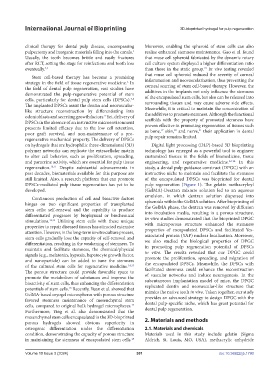Page 309 - IJB-10-3
P. 309
International Journal of Bioprinting 3D-bioprinted hydrogel for pulp regeneration
clinical therapy for dental pulp disease, encompassing Moreover, enabling the spheroid of stem cells can also
pulpectomy and inorganic materials filling into the canals. realize enhanced stemness maintenance. Guo et al. found
3
Usually, the tooth becomes brittle and easily fractures that muse cell spheroid fabricated by the dynamic rotary
after RCT, setting the stage for reinfections and tooth loss cell culture system displayed a higher differentiation ratio
eventually. than those in the static group. In vivo testing revealed
4,5
19
Stem cell-based therapy has become a promising that muse cell spheroid reduced the severity of corneal
strategy in the field of tissue regenerative medicine. In inflammation and neovascularization, thus preventing the
6
the field of dental pulp regeneration, vast studies have corneal scarring of stem cell-based therapy. However, the
demonstrated the pulp-regenerative potential of stem additives in the implants not only influence the stemness
cells, particularly for dental pulp stem cells (DPSCs). 7,8 of the encapsulated stem cells, but also can be released into
The implanted DPSCs assist the dentin and neovascular- surrounding tissues and may cause adverse side effects.
like structure reconstruction by differentiating into Meanwhile, it is critical to maintain the concentration of
odontoblasts and secreting growth factors. Yet, delivery of the additives to promote stemness. Although the functional
9
DPSCs in the absence of an instructive microenvironment scaffolds with the property of promoted stemness have
presents limited efficacy due to the low cell retention, proven effective in promoting regeneration of tissues such
17
20
21
poor graft survival, and non-maintenance of a pro- as bone, skin, and nerve, their application in dental
regenerative mechanical property. The delivery of DPSCs pulp repair remains limited.
on hydrogels that are hydrophilic three-dimensional (3D) Digital light processing (DLP)-based 3D bioprinting
polymer networks can replicate the extracellular matrix technology has emerged as a powerful tool to engineer
to alter cell behavior, such as proliferation, spreading, customized tissues in the fields of biomedicine, tissue
and paracrine activity, which are essential for pulp tissue engineering, and regenerative medicine. 22-24 In this
regeneration. 10,11 Despite substantial advancements in study, a dental pulp guidance construct (DPGC) with an
past decades, biomaterials available for this purpose are instructive niche to maintain and facilitate the stemness
still limited. Also, a research platform that can promote of the encapsulated DPSCs was bioprinted for dental
DPSCs-mediated pulp tissue regeneration has yet to be pulp regeneration (Figure 1). The gelatin methacryloyl
developed. (GelMA)-Dextran mixture solution led to an aqueous
Continuous production of cell and bioactive factors emulsion, in which dextran solution dispersed into
hinges on two significant properties of transplanted spheroids within the GelMA solution. After bioprinting of
stem cells: self-renewal and the capability to produce the GelMA phase, the dextran was removed by diffusion
differentiated progenies by biophysical or biochemical into incubation media, resulting in a porous structure.
stimulations. 12,13 Utilizing stem cells with these unique In vitro studies demonstrated that the bioprinted DPGC
properties to repair diseased tissues has attracted extensive with microporous structure enhanced the stemness
attention. However, in the long-term in vitro culture process, properties of encapsulated DPSCs and facilitated Yes-
stem cells gradually lose the capacity of self-renewal and associated protein (YAP) nuclear localization. Moreover,
differentiation, resulting in the weakening of stemness. To we also studied the biological properties of DPGC
maintain and facilitate stemness, the chemical/physical in promoting pulp regeneration potential of DPSCs
signals (e.g., melatonin, hypoxia, hepatocyte growth factor, in vitro. The results revealed that our DPGC could
and nanoparticle) can be added to tune the stemness promote the proliferation, spreading, and migration of
of the cultured stem cells for regenerative medicine. 14,15 the encapsulated DPSCs. Meanwhile, the DPSCs with
The porous structure could provide favorable space to facilitated stemness could enhance the reconstruction
promote the metabolism of substances and improve the of vascular networks and induce neurogenesis. In the
bioactivity of stem cells, thus enhancing the differentiation subcutaneous implantation model of mice, the DPGC
potentials of stem cells. Recently, Yuan et al. showed that replicated dentin and neovascular-like structure that
16
GelMA-based cryogel microspheres with porous structure mimics the native teeth in vivo. Taken together, our study
favored stemness maintenance of mesenchymal stem provides an advanced strategy to design DPGC with the
cells, compared to original bulk hydrogel microspheres. dental pulp-specific niche, which has great potential for
17
Furthermore, Ying et al. also demonstrated that the dental pulp regeneration.
mesenchymal stem cells encapsulated in the 3D-bioprinted 2. Materials and methods
porous hydrogels showed obvious superiority in
osteogenic differentiation under the differentiation 2.1. Materials and chemicals
condition, demonstrating the capacity of porous structure Materials used in this study include gelatin (Sigma
in maintaining the stemness of encapsulated stem cells. Aldrich, St. Louis, MO, USA), methacrylic anhydride
18
Volume 10 Issue 3 (2024) 301 doi: 10.36922/ijb.1790

